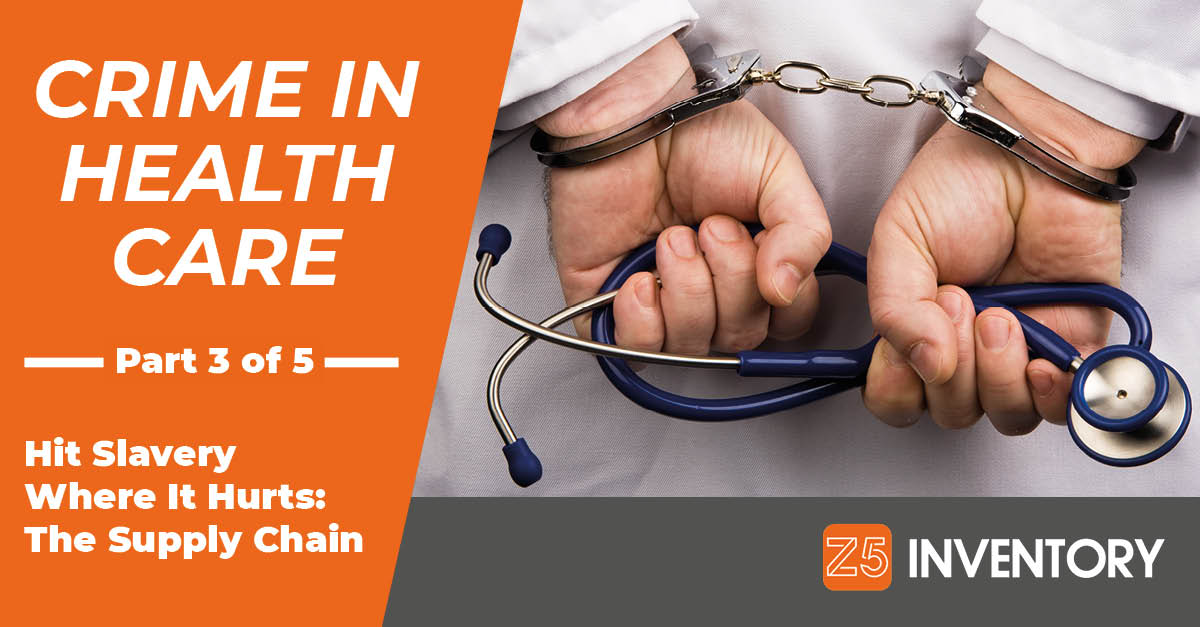Crime In Healthcare - Modern Slavery in the Supply Chain

Slavery is a real problem for the supply chain. And it's up to the supply chain to solve it.
UPDATE: Since we published our Crime In Healthcare blog about cybersecurity, two great articles came out that deserve your attention. One focuses on how vulnerable the supply chain is to cyberattacks, and the other highlights ways you can assess your risk of a data breach. Just thought you should know. Carry on.
You read the title of this blog and made it this far. We’re proud of you for that. But there’s still a chance you’re ready to click away.
We’re hoping your reaction isn’t “Well, that’s not a problem I have to worry about. Next.” (We’re really hoping your reaction isn’t “Why do they keep talking about this?”)
We hope your reaction is something more along the lines of “Is slavery a problem I can help with? How?” Because that’s how action starts. If so, keep reading.
AT THE SMALL SCALE
Eliminating modern slavery – which ought to be called just slavery, but people have a hard time believing that still exists – isn’t just helping slaves directly, although of course we hope you do that, too. Recognizing the signs of trafficking in patients who come through your hospital is the responsibility of every person who works in healthcare, no matter the level or department.
But it’s possible your reaction is still somewhere along the lines of “I’m in the supply chain. I can’t do anything about slavery.”
But that’s exactly where you have the biggest impact.
MAKING A BIG IMPACT
The problem of forced labor is extremely widespread in manufacturing. It affects some of the biggest companies in the world. You can see how well your favorites are doing by consulting the Forced Labor Report Card here.
In healthcare the problem can be just as hard to avoid as it is in shoes and your favorite electronics. (Oh, and all those electronics in your facilities, too.) Big companies worldwide – despite legislation and activism aimed at curbing forced labor – have actually done worse over the last few years.
In the UK, the National Health Service just discovered that their glove manufacturer might be engaging in force labor. Imagine every time you put in an order for more gloves you were contributing to slavery. Terrifying.
If you're buying from companies that use forced labor, you're contributing to slavery. It's that simple. Want to do something about it yet?
WHAT YOU CAN DO
If you feel overwhelmed because you’re just one person, we totally understand that. So here are some simple steps you can take to keep slavery out of your facilities.
- Insist that all your suppliers prove that they’re conflict- and forced labor-free. (If that’s going to be a problem for them, that’s not a supplier you want to work with)
- Consult organizations like Know The Chain, Freedom United, End Slavery Now, and Anti-Slavery International just in case.
- It’s probably worth your time taking the How Many Slaves Work For Me quiz to see what your slavery footprint is personally.
- And, if you’re moved by what you’ve found, get involved with any organization we’ve listed or any others that you find.
- Do more research. This blog? This is nothing. There’s so much more out there to learn. Start with the resources we’ve given you. Keep reading until you’re moved to do something.
This is Part Three in Z5 Inventory’s five-part “Crime In Healthcare” series. To see all the published entries, click here. If you know of a story of healthcare crime that you think we should feature, email info@z5health.com.
